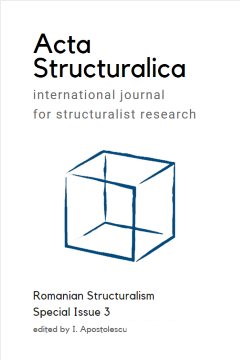This document is unfortunately not available for download at the moment.
Review: Rereading Structuralism Today
Sorin Alexandrescu
pp. 14
unknown
Converted from a Word document
Sorin Alexandrescu
This essay has been first published in Romanian in the weekly Rereading Structuralism TodayObservatorul cultural (Cultural Observer), nr.921, 10-16 May, 2018, p.12-13 and later translated by Alistair Ian Blyth.
I should begin by saying that I gladly welcome the awarding of the Observator Cultural Debut Prize to Adriana Stan. I didn’t know beforehand that she stood a chance and I didn’t try to support precisely because I am part of her area of research and could not allow myself a pro domo initiative. Moreover, I recently met Adriana Stan, in Tîrgu Mureș, after I read her book. I expressed my admiration of the book then and I repeat it now: it fully deserved the prize because of its scholarly qualities, its painstaking and balanced approach, and the justice of what it argues. Thanks to Adriana Stan’s book, this is why I have decided to write not a review, but a more general commentary on structuralism and its reception today.
This return to an intellectual movement of the 1960s and 70s is quite unexpected. More than fifty years have passed since then, during which the subject has very seldom been tackled. Is this the return to the present of a previously forgotten past? If so, what has made it so suddenly topical? Are we looking for something in the past because we are disgruntled with the present? Are we rediscovering structuralism because we again feel the need for structural thinking as an alternative to thinking that is too lax and intuitive? Are we projecting our present-day outlook on the literary theory of that time when we attempt to understand so different a past?
Double reading
Let us remark first of all that Adriana Stan’s reading of the then-theory is not the same as that of many of its readers today. Whereas the latter read the old structuralism with today’s eyes, the author, like every good historian, reads it through the eyes of its readers at the time and the eyes of its readers today, the same as the historian of a mediaeval lord will view him through both the eyes of his contemporaries and our eyes today. Is such a seemingly self-evident dual view usual? I don’t really think so. We all usually look at the past as if it were the present projected back into another historical time. We therefore naturally “know” what people thought at the time as well as we “know” what those around us think today. The literary critic lives in the present, taking occasional looks over his shoulder at the past; the literary historian by definition alternates, or ought to alternate, the two views. But the alternation does not operate by itself. In her introduction to an excellent anthology about Romanians’ thinking about the past, Michèle Mattusch, professor of Romanian, French and Italian literature at the Humboldt University in Berlin, remarks on the tension between personal memory and history in the discussion of the Communist past and argues, “das Pathos des Erfahrenen wiegt schwerer als die kritische Analyse,” the pathos of personal experience outweighs critical analysis (of what happened under Communism).Michele Mattusch (ed.), Kulturelles -Gedächtnis – Ästhetisches Erinnern, Literatur, Film und Kunst in Rumänien, Berlin, Frank & Timme, 2018, p.25. This tension does not seem to operate at all in Adriana Stan’s book; on the contrary, her effective non-participation in the Romanian structuralism of the 1960s and 70s supports an objective critical attitude toward what was then and at the same time a correct appraisal of what was achieved then.
The third attitude
Through her dual outlook, the author has thereby understood what many others do not understand when they read about those years: the structuralists of the time— including myself, a witness, as well as an active participant— were in no way literary critics, nor did they wish to be. They were young university lecturers in linguistics, comparative literature and anthropology, some were even classicists, in the Literature Faculty of Bucharest University, interested in discovering a new way of analysing the construction of meaning in various texts. Nota bene, meaning, rather than value! One of our fundamental sources at the time, the work of René Wellek and Austin Warren, clearly distinguished between theory, history and literary criticism.Teoria literaturii, Bucharest, Editura pentru literatură universală, 1967 (translation by Rodica Tiniş, with an introduction and notes by Sorin Alexandrescu). Of course, if you discuss the meaning of any text, you presuppose, and so does your reader, that it is worth discussing and therefore has a certain public value, but no more than that: the value is presupposed rather than stated as such. It is wrong to conclude today that those young people thereby wished to defend the value of daring books often criticised by the Communist activists of the time: whether we were talking about a poem by Beniuc, a militant communist poet, or a poem by Bacovia, a modern classic, what interested us was how the poem was constructed, nothing more. In fact, we were studying the use of language by the author, and it was this interest that brought together so different groups from the humanities and social sciences of the time. We of course knew of the efforts made by some literary critics to resist ideological pressures; we admired and supported them the best we could, but we did not praise it “obliquely” through the structural analysis of any literary text. Furthermore, we might say that the mere publication of such an analysis was implicitly an act of ignoring ideology. But implicitly, not explicitly. We did not take up structuralism in order to criticise covertly what we were unable to criticise openly; on the contrary, we were fascinated by the possibilities of language and this brought us together, regardless of any secondary effect, although we were of course delighted when such an effect was produced. On the other hand, in talking only about the literary quality of the text, (self-declared) aesthetic literary criticism also ignored ideology, but also implicitly, not otherwise. The defence of Marin Preda, a covert critic of the regime, and the criticism of Zaharia Stancu, its adulatory novelist, were an act of non-conformism, true, but not an act of political resistance. Was this impossible? Perhaps, although it proved to be possible in other Communist countries. But this is not what is at stake here, and therefore let me return to the book we are talking about.
Nonetheless, the claim to an invincible aestheticism that even today does the Homeland honour, a claim made by some literary critics of the time, as well as some literary critics of today, is removed from any historical evaluation. In fact, both they and their Communist adversaries proclaimed a model of absolute truth when making critical verdicts, except that the one was an aesthetic truth, in accordance with inter-bellum democracy, and the other was a menacing political truth, derived from Stalinist fundamentals. The aestheticism of the 1960s and 70s continued the inter-bellum mode of ascribing value to a literary text, greatly influenced by the modernist literary critics Eugen Lovinescu (1881-1943) and, above all, George Călinescu (1899-1965) (Principles of Aesthetics, 1939), the second of whom was comparable with Croce and his aesthetic intuitionism, the first with the French essayists. But Croce’s Aesthetics dated from 1902, and his Breviario di estetica from 1913! The projection of aesthetic values into the absolute and immutable was, however, acceptable as a sotto-voce signalling of inter-bellum democracy, and both enjoyed an indisputable prestige, although both were in fact disputable.
One particular merit of Adriana Stan’s book is precisely the fact—one her critics sometimes find hard to follow—that she removes structuralism from the false dichotomy of above. She positions it where it did in fact reside, in a third position, neither pro nor contra the other two, namely analysis of the construction of the text and language as such, rather than the aesthetic or political values they convey; in other words, the text, beyond its traditional framing within historical genres, themes, literary-historical currents, or areas of folklore. It is this “supremacy” of the text under discussion that explains the so fruitful collaboration between linguists, literati and anthropologists in that period.
Approaches: then and now
Another merit of the author is that she has carefully grasped all the period’s modes of analysing language and has pointed out the similarities and differences between the old, inter-bellum stylistics, mainly developed by Tudor Vianu (1898-1964) after the war, and the major semiotic theories originally put forward by Peirce and Saussure and subsequently developed by Propp, Bakhtin and Lotman, then by the Czech school and the structuralism (proper) of Lévi-Strauss, the analyses of Barthes, Todorov and Genette, the semiotics and psychoanalysis of Kristeva, Louis Marin and Jean Marie Floch’s analysis of the visual image, Greimas’s semiotics of discourse, Wellek and Warren’s New Criticism, Chomsky’s generative grammar, Searle’s pragmatics of discourse, and the major semiotic work of Eco. Many of these directions came down to us via the great linguist Al. Rosetti and Mihai Pop, an anthropologist of broad cultural horizons. I provide the foregoing list precisely because the all-embracing term structuralism, frequently employed in the press, strictly covers only a small segment of what was debated and translated in the Romania of those years. Perhaps it would be more useful to keep the general term “semiotics” rather than “structuralism,” although in France the latter covered almost every method and approach, including those that were philosophically-based. Let me here quote, from the large number of highly precise technical observations on structuralism, two that are highly accurate: “The major shift . . . was the replacement of the idea of individuality with that of the self-refulating system . . . French structuralism rejects essentialist principles and qualitative methods of research. It outlaws discussion of the major themes of ‘the truth,’ ‘meaning,’ ‘value’ other than through the lens of the collective discourses of which they consist” (Bastionul lingvistic. O istorie comparată a structuralismului în România, Bucharest, Editura Muzeul Literaturii Române, 2017, p.179).
Of course, not all of them were adopted and seriously employed by us young people of the time, but anthologies of translations, such as Poetics and Stylistics (1972)Poetică și stilistică, orientări moderne, Mihail Nasta and Sorin Alexandrescu (eds.), Bucharest, Editura Univers, 1972, 701 pp.and studies by Toma Pavel, Virgil Nemoianu, Sanda Galopenția, Mihai Zamfir, and myself, such as my book on Faulkner (awarded the Union of Writers Prize for Criticism in 1969) ensured the public success of the group and its working methods. Our departure from the country, one by one, in the 1970s, inevitably lessened the impact of the method. Toma Pavel’s unexpected repudiation of semiotics, after he had been awarded a doctorate supervised by A.J. Greimas, the en titre representative of semiotics in France, and the reservations of Nemoianu, who was drawn more to comparative literature, diminished the importance of semiotics for its Romanian representatives. Later, I too gradually slid outside semiotics, motivated by the new thinking of Derrida, Deleuze, Lyotard, Foucault, Ricoeur, et al., and later still by the shift of focus from the written text to the visual, a field in which the original concept of the sign was in any case harder to apply. The principle of an interpretation free(r) of strict methods, in the footsteps of Clifford Geertz, the greater interest in social context, and above all the emergence of lines of communication outside the traditional verbal framework (inter-media communication), as well as the new relations between areas of meaning production, such as the relation between society and nature in Bruno Latour, for example, shifted the theoretical spotlight away from the concept of language, text, structure, discourse etc. toward that of the visual image—a relationship between a corps regardant and un medium regardé (Hans Belting)—or toward the visual construction of the social (Tom Mitchell), intertextuality, presence, cultural studies, and so on. François Dosse was therefore right to subdivide his Histoire du structuralisme (1991-2) into two 500-page volumes, titled Le champ du signe (1945-66) and Le chant du cygne (1967 à nos jours). A significant pun: in French, swansong is homophonous with field of the sign, although in writing the meanings could not be more different.
Adriana Stan’s book traces very precisely all these twists and turns in Romania, naturally more than outside the country. The shift in reflection from sign and structure to other concepts regarded as relevant, some of which are mentioned above, depends not on the failure of semiotics, but on the general dynamic of science in the western world, where, at least once a generation, analytical attention moves from one object to another through the internal dynamic of research, the emergence of new points of interest or intellectual and methodological configurations whereby the old methods lose not their value, but their topicality. Differently than in the older histories of science, the disappearance of a working model is not due to the fact that its flaws have been demonstrated, as was once the case, but rather because a new model quite simply provides new modes of thinking or acting. On the other hand, old ideas also re-emerge, re-circulate, are given a second chance, albeit having been altered and now expressing nuances not apparent on their first appearance due to who knows what psychic or social reasons.I discussed a revival concerning the historical avant-garde in my essay, “Dincoace și dincolo de Real: Ion Grigorescu versus Ștefan Câlția” (Hither and Yon of the Real: Ion Grigorescu versus Ștefan Câlția), in Observator cultural, 14-20 December 2017, pp.12‑14.
Re-start?
Does such a situation exist here too? It is not obvious, but that does not mean it is out of the question. The lengthy work Adriana Stan put into the writing of this book, as well as the unanimity (I think) of the praise for it reveals (once again, I think) an absence, namely, precisely what Adriana Stan named (interestingly, by negation!) in her wonderful prize acceptance speech in Observatorul Cultural, no. 913: “In our literature, unfortunately, journalistic criticism and scholarly criticism have often come head to head. Probably sooner because of lingering clichés rather than because of their nature. In fact, I think that the two ought rather to put their heads together and form a more coherent image of the way literature is going.” Yes, they ought to, but can anything of the sort be glimpsed yet? In Romania today, is there scientific criticism or are there philosophical essays on literature or art comparable with what is constantly published in other countries? Neither is very apparent. Obviously, the first thing to ask is what we understand today by scientific criticism or the philosophical essay. For the first, some might point to Franco Moretti as a model, but I don’t think that intensive use of computers for a distant reading of texts, as he says, automatically guarantees it is science. In the quotation above, Adriana Stan expresses herself in the optative rather than the indicative. The optative is a desideratum, probably permanently valid, but only the indicative expresses a real existence in time. The true—and great—merit of the author is that she expresses this optative by pointing to an indicative moment (the only one?) in Romanian culture in which journalistic criticism and scientific criticism have willy-nilly “come head to head.”
And another thing, whereby I return to the questions posed at the beginning of this essay and to the special topicality of this book. The full title is very long: The Linguistic Bastion: A Comparative History of Structuralism in Romania. Two words are surprising both before and after you read the book. Why linguistic bastion? Did the structuralists think they were invincible? Perhaps, but they were wrong: they were not vanquished, but forgotten; the victors were not those who attacked them in Romania, but those who ignored them and continued to shut themselves away in their timeless aestheticism. Both groups believed in clichés, suggests the author, but in her title, she also points to the fact that the history now written is “comparative.” Yes, Adriana Stan is one of the few Romanian authors in the field who have analysed the situation here in permanent comparison with what happened in other countries. Although unfortunately, Romania is now the only country (I think!) of all those I know (to a greater or lesser extent) where a single kind of criticism dominates, the one the author calls journalistic criticism.
Perhaps the true, deeper message of the book is the intelligent message revealed/concealed by the author: here, the structuralist moment was one in which the “two criticisms” existed together, the same as in almost every other culture in the world. But the balance was then broken, leading to a kind of monotheism. There’s nobody like us, the eternal Romanian wag would mutter. I don’t believe him; I subscribe to the book’s deeper message, for which I especially thank the author, because I still wish there to be something in my country comparable with what can be found in other countries.
Words 2.842
Characters (with spaces) 17.742
- Alexandrescu Sorin (2017) "Dincoace și dincolo de Real: Ion Grigorescu versus Ștefan Câlția", Observator cultural 12 (14-20), pp.12-14.
- Călinescu George (1939) Principi de estetica, Bucureşti, Fundaţia Regală pentru Literatură şi Artă.
- Dosse François (1991) Histoire du structuralisme: I. Le champ du signe, 1945-1966, Paris, La Découverte.
- Dosse François (1992) Histoire du structuralisme: II. Le chant du cygne, 1967 à nos jours, Paris, la Découverte.
- Mattusch Michele (2018) Kulturelles Gedächtnis: sthetisches Erinnern, Literatur, Film und Kunst in Rumänien, Berlin, Frank & Timme.
- Nasta Mihai, Alexandrescu Sorin (1972) Poetică și stilistică: Orientări moderne, Bucureşti, Editura Univers.
- Stan Adriana (2017) Bastionul lingvistic: O istorie comparată a structuralismului în România, Bucureşti, Editura MLR.
- Wellek René, Warren Austin (1967) Teoria literaturii, Bucureşti, Editura pentru literatură universală.



